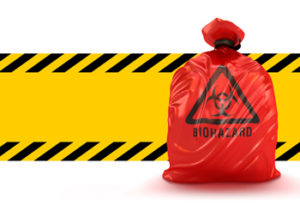
By Dr. Katherine Schrubbe, RDH, BS, MEd, PhD.
Rules, regulations and standards of care abound in the dental profession. In order for the dental team to comply, all team members must have a clear understanding of the requirements and mandates. In short, it can be overwhelming.
While the primary goal of the dental practice is to provide the highest quality patient care and the best patient experience – all while ensuring patient and staff safety – team members must be efficient, well-organized and competent in the completion of the tasks and duties related to the requirements and mandates. This creates a culture of standardization and calibration. The instrument processing protocols, how to prepare and turn over operatories, and hand hygiene are all examples of tasks that should happen like clockwork. What to dispose of – the where and how of waste management – is also one of those tasks. Dental team members who are unsure of the appropriate steps to take may be making costly errors that hurt the dental practice.
Managing medical waste in the dental setting
Let’s review the types of medical waste produced in the dental setting and the protocols for management and disposal. It should be noted that the Centers for Disease Control and Prevention (CDC) states that dental healthcare facilities should dispose of medical waste regularly to avoid accumulation, and any facility generating regulated medical waste should have a plan for its management that complies with federal, state and local regulations to ensure health and environmental safety. Also, dental team members handling waste should be trained in appropriate methods and informed of the potential hazards.1
 Having a clear plan, as well as understanding the risks involved, will streamline processes and productivity related to medical waste disposal. Many times, team members are confused with the terms defining the various types of waste. There are basically two types of waste generated in dental practices: regulated and nonregulated medical waste. General medical waste is defined as any solid waste that is generated in the diagnosis, treatment or immunization of human beings or animals in research pertaining thereto, or the production or testing of biologicals. (The term excludes hazardous and household waste.). Only a small percentage of medical waste is infectious and needs to be regulated.2,3,4 Infectious waste, which is regulated, is a very small subset of medical waste (about 3 percent) that has proven to be capable of transmitting an infectious disease.3
Having a clear plan, as well as understanding the risks involved, will streamline processes and productivity related to medical waste disposal. Many times, team members are confused with the terms defining the various types of waste. There are basically two types of waste generated in dental practices: regulated and nonregulated medical waste. General medical waste is defined as any solid waste that is generated in the diagnosis, treatment or immunization of human beings or animals in research pertaining thereto, or the production or testing of biologicals. (The term excludes hazardous and household waste.). Only a small percentage of medical waste is infectious and needs to be regulated.2,3,4 Infectious waste, which is regulated, is a very small subset of medical waste (about 3 percent) that has proven to be capable of transmitting an infectious disease.3
The Bloodborne Pathogens standard uses the term regulated waste to refer to the following categories of waste, which require special handling:
- Liquid or semi-liquid blood or other potentially infectious material (OPIM).
- Items contaminated with blood or OPIM, which would release these substances in a liquid or semi-liquid state if compressed.
- Items that are caked with dried blood or OPIM and are capable of releasing these materials during handling.
- Contaminated sharps.
- Pathological and microbiological wastes containing blood or OPIM.5
Most of the regulated waste in dental offices consists of contaminated sharps and extracted teeth. However, other examples of regulated medical waste categories in dentistry, such as those listed above, include liquid blood or saliva; two-by-twos or cotton rolls saturated/caked with blood or saliva; used needles, scalpel blades, ortho wires, broken sharps instruments, burs, biopsy specimens and excised tissue.3
The practice management team must be certain that dental team members are trained and have a clear understanding of how to separate regulated waste from nonregulated waste to ensure a purposeful segregation. The practice incurs a cost from regulated waste because it must be picked up and transported off-site by qualified waste hauler vendors; therefore, only items that are considered infectious should be placed in regulated waste receptacles (commonly known as the red biohazard bags or red biohazard sharps containers).
Non-sharp regulated waste items, such as those listed above, must be disposed of in red biohazard bags. Contaminated sharps, however, must be disposed of in red biohazard sharps containers. OSHA points out that contaminated sharps shall be discarded immediately or as soon as feasible in containers that are closable, puncture resistant, leakproof on the sides and bottom and labeled or color-coded. OSHA also states that, during use, containers for contaminated sharps shall be easily accessible to personnel and located as close as is feasible to the immediate area where sharps are used or can be reasonably anticipated to be found, maintained upright throughout use, replaced routinely and not allowed to overfill. Lastly, when moving containers of contaminated sharps from the area of use, OSHA states that containers shall be closed immediately prior to removal or replacement to prevent spillage or protrusion of contents during handling, storage, transport or shipping, and placed in a secondary container if leakage is possible. The second container shall be closable; constructed to contain all contents and prevent leakage during handling, storage, transport or shipping; and labeled or color-coded according to this standard. Reusable containers shall not be opened, emptied or cleaned manually or in any other manner that would expose employees to the risk of percutaneous injury.6
The CDC recommends that sharps containers be located as close as possible to the work area.1 Accordingly, every operatory should have a red biohazard sharps container, which should be stored in a place inaccessible to small children who could mistake a red container for a toy or surprise box.
Once procedures are complete, staff members should dispose of any disposable sharps in the operatory sharps containers. All other used items from patient care that have not been disposed of in red biohazard bags or sharps containers may be safely thrown out in the regular trash. Items such as barriers, gloves, masks, bibs, lightly soiled gauze and cotton rolls are not considered infectious or dangerous to the environment.3
Medical waste is primarily regulated by state environmental and health departments. The Environmental Protection Agency (EPA) has not had the authority to oversee the handling of medical waste since the Medical Waste Tracking Act (MWTA) of 1988 expired in 1991. It is important for the dental team to contact their state environmental program before they dispose of medical waste. They should contact their state environmental protection agency at www.epa.gov, as well as their state health agency, for more information regarding their state’s regulations on medical waste.2
It should be noted that the dental practice remains responsible for the regulated waste it generates until it is destroyed or rendered non-hazardous. This concept, which is called cradle-to-grave liability, means that even after waste leaves the practice, any cleanup for any damage it may cause is the responsibility of the generator (the practice); so, the practice should carefully select a licensed waste hauler.3,4
Recordkeeping for the disposal of waste must meet state regulations. The most critical record is the waste manifest – a tracking document that comprises the name of the generator (dental practice), transporter, disposer and the waste itself. It also may include the description and quantity of waste, date, type of container and the type of final disposal.4 All manifest records must be kept for three years.4
The management of medical waste in a dental practice is a critical component of compliance to federal, state and local agency standards. Regardless of the practice size, all dental team members must be aware of what to dispose of, and how and where to dispose of it. Otherwise they risk taking a haphazard approach to the disposal of hazardous materials, causing potential risk to patients and staff, as well as the environment.
References
- Centers for Disease Control and Prevention. Guidelines for Infection Control in Dental Health-Care Settings — 2003. MMWR 2003;52(No. RR-17). Available at: https://www.cdc.gov/mmwr/preview/mmwrhtml/rr5217a1.htm. Accessed November 18, 2018.
- U.S. Environmental Protection Agency. Medical Waste. Available at https://www.epa.gov/rcra/medical-waste#who%20regulates%20medical%20waste. Accessed November 18, 2018.
- Miller CH, Palenik CJ. Infection Control and Management of Hazardous Materials for the Dental Team. 5th ed. St. Louis: Mosby Elsevier; 2013;192-196.
- OSAP Interact Training System Workbook. OSHA and CDC Guidelines; Combining Safety with Infection Control and Prevention. 5th Edition; 2017.
- U.S. Department of Labor. Occupational Safety and Health Administration. Bloodborne Pathogens Standard; 1910:1030. Most frequently asked questions concerning the bloodborne pathogens standard. Available at https://www.osha.gov/laws-regs/standardinterpretations/1993-02-01-0#waste. Accessed November 18, 2018.
- U.S. Department of Labor. Occupational Safety and Health Administration. Bloodborne Pathogens Standard; 1910:1030. Available at https://www.osha.gov/laws-regs/regulations/standardnumber/1910/1910.1030. Accessed November 18, 2018.
Editor’s note: Dr. Katherine Schrubbe, RDH, BS, M.Ed, PhD, is an independent compliance consultant with expertise in OSHA, dental infection control, quality assurance and risk management. She is an invited speaker for continuing education and training programs for local and national dental organizations, schools of dentistry and private dental groups. She has held positions in corporate as well as academic dentistry and continues to contribute to the scientific literature. Dr. Schrubbe can be reached at [email protected].

